Baking bread is both pure science and utter magic. It’s a straightfoward process that works almost without fail, yet is amazing every time. (I say almost because even the most seasoned chef will tell you that things go wrong sometimes, and I am not one of those.) There’s just something about the way that a mess of ingredients becomes, unmistakeably, bread dough.
I see it as a bit of a rite of passage, one of those things aspiring cooks should try at least once. It’s one of the most satisfying things I do in the kitchen, and that remains true regardless of how many times I do it. I have a friend who likes “Katie bread” so much I once brought two pans of dough to his house, baked them fresh, and gave them to him as a birthday gift right out of the oven.
“Katie bread” began as a white bread recipe that I have misplaced the link to. Sometime during the year when I sort of accidentally ended up baking weekly bread for us, I refined it one pair of loaves at a time. Added a little more salt. Reduced the sugar slightly. Swapped in white whole wheat flour, then swapped some of it back out. It’s a basic white-wheat bread, sturdy enough for sandwiches and fantastic slathered with butter.
There is a bit of a learning curve, but I don’t mean to intimidate you by that. What I mean is that if you haven’t baked much before, you might be surprised at how genuinely bread-like your first attempt is. The next will be better. The next, better still. If you keep going, eventually the way activated yeast smells and the way well-kneaded dough feels will embed into your hands and heart. You’ll just know when it’s right.
Making Sense of the Magic
Some people maintain that baking is complicated, or has too many rules. To this I say that it does have more constraints than cooking, where you can make changes with relative impunity, but bread at least is fairly forgiving. You can swap out flours. You can use a little more water or a little less. You can add stuff.
There’s some basic principles of bread that I’d like to break down for you. Bread-baking is a bit of a black hole that you can happily throw yourself down, but here are some basics that will serve you well.
What is active dry yeast and why is it magic?
It’s aliiiiiiive! Yeast is actually a fungus. When you stir it into warm water, you sort of wake it up (not hot water, that will kill it literally dead) and it begins to ferment, creating bubbles with a delicious, distinctive smell. It comes in packets or jars. If you plan to bake more than once, definitely buy a jar; it’s cheap and keeps for months in the fridge.
I have instant yeast, can I use that instead?
Yes! Instant yeast is basically the same but smaller as active dry, so it doesn’t need to be dissolved. If that’s what you’re using, you can combine the first and second steps of this recipe.
Why did you write out this recipe in cups AND grams?
Baking is a discipline where small amounts can make a difference. While this recipe will certainly work if you use cups, grams will give you more precise measurements…and a better jumping off place for perfecting your own version. (See this ingredient weight chart for more info.)
Why are you weirdly specific about the type of salt?
Different types of salt (sea, kosher, table, etc.) taste more or less the same (not counting fancy flavored ones). But they don’t weigh the same. That means that a tablespoon of fine-grained table salt will be waaay saltier by volume than a tablespoon of large-grained kosher salt. When I developed this recipe, I was using the classic Morton (salt girl) table salt, so that’s how this is measured (see this chart by Dad Cooks Dinner for some conversions). Same thing with the sugar–I often use unbleached cane sugar these days, but I developed this recipe using common white sugar.
Why two types of flour?
I like the health benefits of whole wheat flour, but I’m not a huge fan of the texture. Whole wheat also bakes up much denser and less bouncy than white bread. To that end, I’ve found that I like my bread to be just-slightly-under-half white whole wheat (a softer, less intense kind of whole wheat). Your mileage may vary.
What is kneading about?
Kneading, the stage when you fold the dough repeatedly before setting it to rise, is a physical manipulation of gluten. Gluten proteins come in long strands, and when you knead, you slowly persuade them take structured shapes that make bread springy.
Kneading should be done on a large flat surface sprinkled with flour (I like to clean the counter well and use that; a large cutting board works too). To knead, just fold the dough in half towards yourself, push to flatten very slightly, and turn 90 degrees. Repeat (repeat repeat repeat). Stop for more flour if it starts to stick to you or the counter, and for stretch breaks for your forearms. (You can also let a stand mixer do this for you.)
Continue until the dough feels smooth and when you poke it with a finger, it slowly springs back into shape. If you pick it up with one hand and let it sag towards the counter, you can actually see that it stretches in long strands like spaghetti or muscles.
Why does this take so long?
Look, I love fast and easy too, but some things can’t be rushed. Rising bread is one of them. The yeast continues to ferment, which develops flavor and puts off more gases, causing the dough to expand. Maybe it’s not worth doing every week, but it’s worth trying at least once.
…although if you really really can’t wait, check out the final question:
Where can I learn more about the strangely seductive world of bread baking?
I used this primer by Epicurious to develop this recipe. If you’re interested in science and/or no-knead bread, try this series by Serious Eats, and this fabulous book “The New Artisan Bread in Five Minutes a Day.”
PrintKatie Bread
- Prep Time: 0 hours
- Cook Time: 0 hours
- Total Time: 2 hours 30 minutes
- Yield: 2 loaves 1x
- Category: bread
Ingredients
- 1 1/2 tablespoons active dry yeast (2 packages) (14 grams)
- 3 1/2 tablespoons white granulated sugar (43 grams)
- 2 1/4 cups warm water (500 grams)
- 3 tablespoons softened unsalted butter (42 grams)
- 1 rounded tablespoon table salt (20 grams)
- 3 1/2 cups bread flour, with extra for kneading (420 grams)
- 3 cups white whole wheat flour (339 grams)
Instructions
- In a large bowl, stir yeast and sugar into warm water until dissolved. Allow to sit for 10 minutes.
- Mix in 2 cups of flour, butter, and salt. Stir the remaining flour in 1/2 cup at a time, mixing well after each time. Add a little extra flour or water if the dough looks too wet or dry.
- When the dough comes together, turn out onto a lightly floured surface. Knead until dough is smooth and elastic, about 5 minutes.
- Lightly oil the bowl and place dough inside, turning to coat. Cover loosely and place somewhere warm to rise until doubled, about 1 hour.
- Lightly grease two bread pans. Turn dough back onto lightly floured surface and knead a couple of times to deflate. Divide in half, gently shaping into rough loaves, and place in the pans. Return pans to a warm place and let rise again, about 40 minutes.
- Preheat oven to 425 degrees. Put the loaves in and immediately turn the heat down to 375. Bake for about 30 minutes, or until top is golden brown and the inside measures 190 degrees.
- Turn loaves onto a wire rack. Allow to cool completely before cutting (if you can stand it). Store any leftovers in a bread box or wrap loosely with plastic.

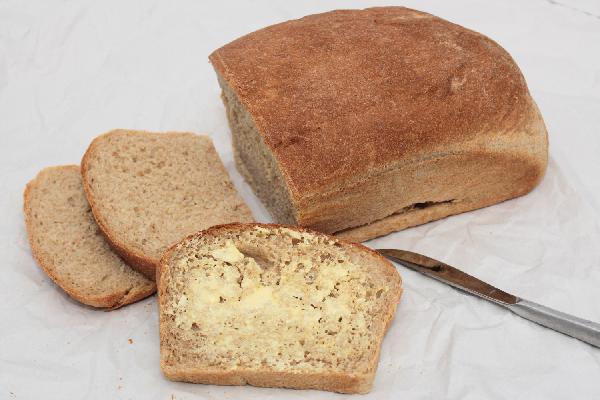

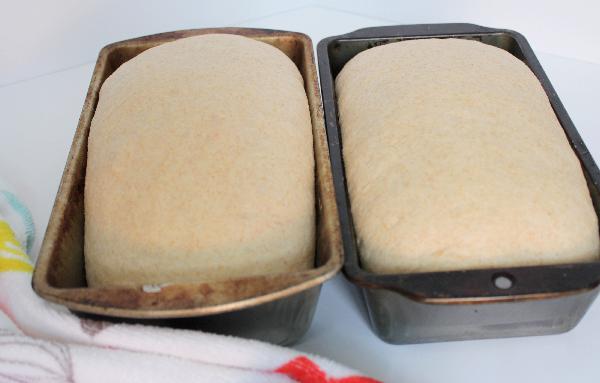
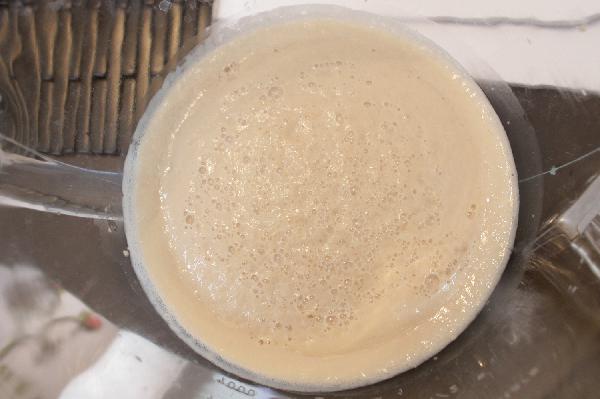
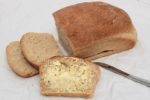
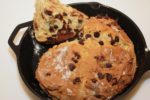
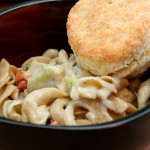
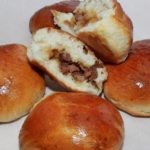
[…] for more bread? Try “Katie Bread,” a perfect basic sandwich bread. Or for another yeast-free recipe with a sweet twist, try […]
[…] thing to remember is DO NOT HEAT ANYTHING SO HOT THAT YOU KILL THE YEAST. Remember, yeast is aliiiive, and it can overheat and die. That said, having warm ingredients encourages the […]